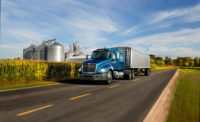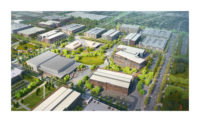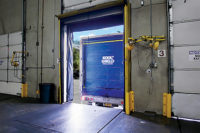Walmart Debuts Futuristic Tractor-Trailer Combination

Walmart, Louisville, Ky., introduced the Walmart Advanced Vehicle Experience, a tractor-trailer combination that features leading-edge aerodynamics, an advanced  turbine-powered range extending series hybrid powertrain, electrified auxiliary components and sophisticated control systems all in one package.
turbine-powered range extending series hybrid powertrain, electrified auxiliary components and sophisticated control systems all in one package.
In 2005, Walmart announced its goal to double fleet efficiency by 2015. As of last year, the company achieved an 84% improvement in fleet efficiency over its 2005 baseline.
“Walmart is continually looking for innovative ways to increase our efficiencies and reduce our fleet’s emissions,” said Tracy Rosser, senior vice president of transportation. “The Walmart Advanced Vehicle Experience is a bold step in transportation technologies that although not on the road in its current form, will serve as a learning platform for the future that will accelerate our progress toward our goals.”
Although the prototype currently runs on diesel, its turbine is fuel neutral and can run on compressed or liquid natural gas, biofuels or other fuels.
The prototype is the result of collaboration between Walmart and many vendors, including Peterbilt Motors Co., Denton, Texas; Roush Engineering, Livonia, Mich.; Great Dane Trailers, Chicago; and Capstone Turbine Corp., Chatsworth, Calif.
About the Walmart Advanced Vehicle Experience
Tractor. Walmart and Peterbilt have collaborated on aerodynamic, hybrid, electrification and alternative fuel projects in the past, each with incremental gains in fuel efficiency and emission reductions. The Walmart Advanced Vehicle Experience tractor combines many of these projects in a single vehicle.
“Peterbilt’s goals of producing the most fuel-efficient, aerodynamic and lightweight trucks in the industry mirror those of Walmart,” says Landon Sproull, chief engineer at Peterbilt. “Our combined efforts help build a business case for these technologies in the future, as well as support one of our best customers.”
Aerodynamics. Designers used extensive computational fluid dynamics (CFD) analysis to optimize the truck’s styling. The truck’s shape represents a 20% reduction in aerodynamic drag over Walmart’s current Peterbilt Model 386. By placing the cab over the engine, the truck’s wheelbase is greatly shortened, resulting in reduced weight and better maneuverability. Walmart relied on product development supplier Roush Engineering to carry out the vehicle’s construction with these detailed design specifications.
“We work every day with customers from the automotive and aerospace industries, all of whom have a laser focus on maximizing efficiencies through improved aerodynamics,” says Tom Topper, Roush’s executive director of prototype services. “This design is revolutionary and truly world class.”
Range extending series hybrid. Range extending hybrids are a synergy between electric trucks and series hybrids, and their design reduces the energy storage size required for trucks to run on batteries alone. With Walmart distribution centers now located closer to metropolitan areas, transport vehicles have shorter transit times to their delivery destinations. These shorter trips reduce the vehicles’ average trip speed and create more opportunities to recover energy through regenerative braking. The generator and energy storage on the truck are scalable based on the range desired.
Turbine power. The truck features a microturbine range extender generator developed by Capstone Turbine. The company also engineered the truck’s integrated hybrid drivetrain solution. The use of a hybrid powertrain allows the turbine to remain at optimum operating revolutions per minute (RPM), while the electric motor/energy storage handles acceleration and deceleration. A longer-range version of this powertrain would feature a larger turbine and smaller energy storage system.
“We developed this microturbine hybrid electric drive system by assembling the best team of technology leaders in the industry,” says Steve Gillette, director of business development for Capstone. “We look forward to the day when these energy-saving features are standard offers for the market.”
Fuel neutral capability. Turbines by their nature are fuel neutral and produce very low emissions without the need for after-treatment. Turbines are also appealing because of their few moving parts, low maintenance requirements and lighter weight.
Component electrification. With automobiles moving to electrified accessories such as power steering and air conditioning, this truck scales those systems up for use on a larger vehicle. These electrified components are used only when needed and at peak efficiency.
Charge mode. When keyed on, the truck automatically detects the state of charge of the batteries and starts charging them, if needed, using the turbine engine. Charge mode can be manually selected if an operator wishes to “top off” the batteries prior to shutting down.
Electric vehicle mode. For use in urban areas, the truck will run on electric power alone until the battery state of charge hits 50%. At that time, the turbine will automatically start and begin charging the batteries.
Hybrid electric mode. For maximum range, this mode runs the turbine continuously, only shutting down if the batteries run out.
Trailer. The vehicle’s trailer, manufactured by Great Dane Trailers, offers a host of fuel-saving features. The trailer body is built almost exclusively with carbon fiber, including 1-piece carbon fiber panels for the roof and sidewalls, saving nearly 4,000 pounds when compared to traditional designs. The trailer’s convex nose also enhances aerodynamics while maintaining storage space inside the trailer.
Other special features of the trailer include special low-amperage LED lighting strips, composite trailer skirts, aerodynamic disc wheel coverings, a Posi-lift suspension and a 1-piece, fiberglass-reinforced floor panel with a 16,000-pound forklift rating.
“This road-ready prototype trailer is a bold step in transportation technologies,” says Adam Hill, vice president of product and sales engineering at Great Dane. “We look forward to further collaboration with Walmart to create more fuel-efficient vehicles of this type in the future.”
Looking for a reprint of this article?
From high-res PDFs to custom plaques, order your copy today!





